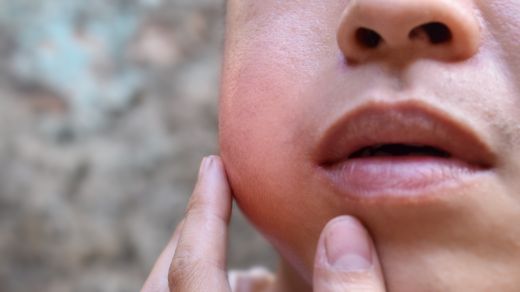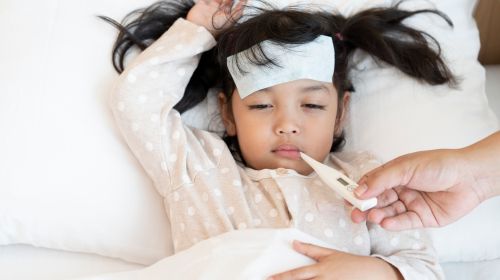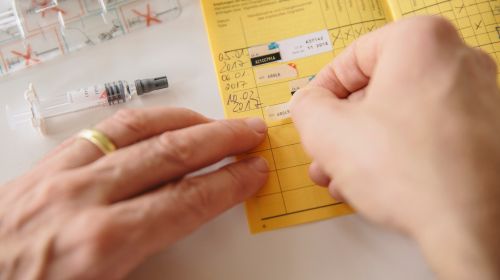Mumps is a viral disease that causes flu-like symptoms and often affects children. Typical for mumps is the painful swelling of the parotid gland on one or both sides. If you want to prevent serious complications, you should get a vaccination.
- © ZayNyi – stock.adobe.com
Quick overview: Mumps (parotitis epidemica)
Definition: Mumps is an infectious disease caused by the mumps virus. The disease occurs primarily in childhood and is therefore one of the classic childhood diseases. But adults can also become infected.
Signs of illness: Mumps is characterized by inflammation of the parotid gland, which manifests itself as swelling of the cheek or neck. In addition to hamster cheeks, a general feeling of illness and fever are possible.
Infection: Infection occurs via droplet infection or direct contact with infectious saliva.
Treatment: There is no targeted therapy or medication available for mumps. Painkillers and home remedies such as cool compresses can help with the symptoms.
Vaccination: There is a vaccination against mumps. A combination vaccine against measles, mumps and rubella (MMR) is administered.
Course: In some cases, complications such as meningitis, pancreatitis or, in boys and men, testicular inflammation occur.
Article contents at a glance:
What is mumps?
Mumps – also known as goat’s pet or parotitis epidemica – is a widespread, contagious viral disease. The infectious disease most commonly occurs in children over the age of two, which is why it is considered a childhood disease like measles and chickenpox. However, older children, adults and babies can also become infected. Boys get the disease twice as often as girls.
In Germany, mumps infections are now rare due to the vaccination. Nevertheless, cases of mumps still occur, especially among unvaccinated people.
Symptoms: How can mumps be recognized?
Once mumps breaks out, symptoms similar to the flu occur. General signs of illness such as:
- Weariness and fatigue
- Lack of strength
- Fever
- Body aches and headaches.
In the first three days, inflammation of the parotid gland typically occurs. Initially only one side is usually affected. The tissue around it swells. The swelling is reminiscent of hamster cheeks.
In most cases, the other side of the neck also swells after three to four days. The swelling is tender to painful and makes chewing and swallowing difficult. The pressure on the ear canal causes ear pain, and opening the mouth wide is also painful. The throat is dry because the salivary glands no longer produce saliva.
In some cases, the testicles or ovaries are affected – this manifests as swollen, painful testicles or pain in the lower abdomen. However, at least a third of infections occur without or only minor symptoms. Especially in small children under the age of five, symptoms often only appear cold-like. In many cases, mumps therefore remains undetected.
Routes of infection: This is how mumps is transmitted
The disease is caused by the mumps virus. The mumps viruses are transmitted from person to person via droplet infection via the saliva of sick people, for example by sneezing, coughing or speaking. Infection is also possible when kissing. Objects that come into contact with infected saliva, such as dishes, are also a source of infection. Experts then speak of a smear infection.
Even infected people who do not yet have any symptoms can pass on the disease: the period of infection begins seven days before the onset of the disease and lasts until around nine days after the onset of the disease. However, infected people are most contagious between two days before and four days after symptoms appear.
The incubation period, i.e. the period between contact with the virus and the outbreak of the disease, is usually 16 to 18 days. It can also be slightly shorter or longer. Even those who have no symptoms can infect others.
Mumps usually leaves you with lifelong immunity: If you survive the disease once, you usually won’t get it again. Secondary infections can occur, but are rare.
This is how mumps is diagnosed
Anyone who notices signs of mumps in themselves or their child should have the diagnosis confirmed by a doctor. The detection of mumps antibodies in the blood provides certainty. These antibodies are often undetectable in people who develop mumps even though they have been vaccinated. In these cases
- the urine,
- a throat swab,
- or dental crevicular fluid
examined for the virus itself. Mumps is considered a notifiable disease in Germany, which is why doctors must inform the responsible health authority any time they suspect an illness. In the event of a mumps infection or even if it is simply suspected, those affected are not allowed to go to community facilities such as daycare centers, kindergartens or schools. The responsible health authority will determine when this ban will be lifted.
Treatment for mumps: relief of symptoms
Since mumps is a viral infection, antibiotics do not help. There is no special therapy or medication that is effective against the virus. Treatment is therefore usually limited to relieving the symptoms. The following measures and home remedies help provide relief:
fever-reducing or pain-relieving medications
drink a lot
cold or warm compresses on the throat and neck
If you have difficulty swallowing: liquid or mushy food
Gargle with salt water
Bed rest (only if you have a high fever)
If the testicles become inflamed as a result of mumps, strict bed rest must be observed. The testicles should be cooled and elevated. Some serious complications, such as meningitis, require hospital treatment.
Course and prognosis for mumps
As a rule, mumps disease progresses without any further complications. However, occasionally the disease can spread to the pancreas. In this case, those affected have symptoms such as abdominal pain, vomiting and nausea. Other possible complications include:
The likelihood of complications increases the older those affected are. Adolescents from the onset of puberty or adult men develop painful testicular inflammation (orchitis) in 20 to 30 percent of cases, which can sometimes lead to infertility. In women, inflammation of the fallopian tubes and mammary glands is possible. In rare cases, a mumps infection leaves people deaf for life.
Preventing mumps: protecting vaccinations
A vaccination is available against mumps and is recommended by the Standing Vaccination Commission (STIKO) at the Robert Koch Institute. However, there is no single vaccine in Germany: vaccination is done with a so-called measles-mumps-rubella combination vaccine (MMR vaccine), which simultaneously immunizes against two other childhood diseases.
For children, the first vaccination should be between the ages of 11 and 14 months. The second dose is administered no earlier than four weeks after the first vaccination and no later than the end of the second year of life. If the child is cared for earlier in a daycare center or other community facility, the first vaccination can take place at nine months. As a rule, the U6 early detection examination is suitable for the vaccination appointment with the MMR vaccine.
Since mumps can lead to serious complications, especially in older children and adults, a missed vaccination should be done as soon as possible. This is particularly true for people who work with children or in community facilities.
Unvaccinated people who have had contact with infected people can get the vaccination protection within three days in order to subsequently prevent an outbreak of the disease.


